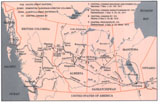J.D. McArthur’s Dream of the “Trans-Prairie” Railway
Under the 1917 amendment to the charter of the McArthur’s Central Canada and Power Company (Manitoba 1905) permission was granted to build a railway from the City of St. Boniface (Winnipeg) north along the east side of Lake Winnipeg and west to a point between the latitudes 55° and 56°.
Under Section 7(e) of the Central Provinces Railway charter (Saskatchewan 1913) McArthur could then connect the Manitoba line with his Central Canada Saskatchewan Railway (Saskatchewan 1917) at Prince Albert. This line was to run to the Saskatchewan-Alberta border between Townships 61 and 63, where it would join the Central Canada Railway (Alberta 1913, amendment 1915) that McArthur was building south-east from Dewar on the Alberta and Great Waterways Railway (Alberta 1909).
Trains would then travel over the Alberta and Great Waterways Railway to Edmonton and there connect up with the Edmonton, Dunvegan and British Columbia Railway (ED&BCR), Dominion 1907, which was chartered to build to Fort George (Prince George), British Columbia, via Dunvegan and the valleys of the Peace and Parsnip rivers. There the CCR would link up with the Grand Trunk Pacific Railway, with whom McArthur had close business ties.1
This route was not followed by McArthur when he acquired the charter of the ED&BCR from the GTPR in 1911.2 Instead the railway followed a more circuitous route and rather than going west from Spirit River to Pouce Coupe, B.C. (though the line was graded to the provincial boundary) the line was diverted to Grande Prairie, only reaching Hythe, Alberta almost two years to the day of McArthur’s death in Winnipeg on January 10, 1927. The Northern Alberta Railways (Dominion 1929) line, successor to the ED&BCR line, did not reach Dawson Creek until 1930. And it was not until 1958 with the arrival of the Pacific Great Eastern Railway (British Columbia 1912) at Dawson Creek, that a connection was made with Prince George.
J.D. McArthur’s dream of a “trans-prairie” railway was never fully realized, but his impact on Alberta was profound. He has yet to be accorded the recognition that his life and work fully deserves.
Notes | Bibliography | Abbreviations
1. G. Taylor, The Railway Contractors: The Story of J.W. Stewart, His Enterprises and Associates (Victoria: Morris Publishing, 1988), pp. 79, 88.2. Ibid., p. 88. Note: The Central Canada in Alberta was also built to Peace River from the ED & BC with proposed extensions north and west, the latter’s goal probably Dawson Creek. The CC only got as far as Hines Creek.

